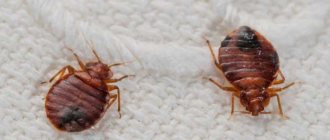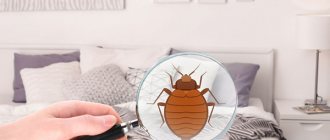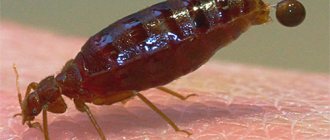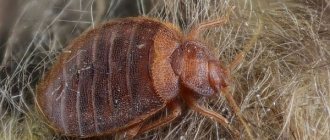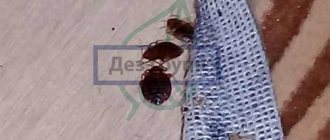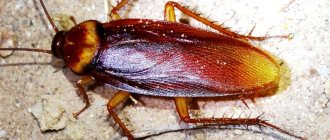Bedbugs are small wingless insects that feed on human blood. They enter the house with contaminated furniture, clothes, bags, and pass from neighbors. Their presence results in restless sleep and skin problems. To completely eliminate parasites, you need to know where bedbugs live. In the place where they accumulate there are eggs, adults and larvae. This is the only opportunity to eliminate the source of infection.
Where do bedbugs hide in an apartment?
House bugs settled in human homes several thousand years ago. They chose comfortable conditions and proximity to food. In warm conditions, insects reproduce all year round, and generations of parasites constantly expand their territory. Bed bugs have long ceased to be a sign of unsanitary conditions. They appear in clean, tidy apartments and luxury hotels.
Arthropods live secretly, appearing only at night. To detect and destroy them, it is necessary to find out the habitats of bedbugs. The greatest likelihood of finding parasites is when examining the sleeping area. They crawl slowly and reluctantly, and also take care of their offspring. The proximity of a person is a decisive factor when choosing a site for a nest. The search for insects in the apartment begins from the following places:
- bed, sofa - places to sleep;
- upholstered furniture (armchairs, chairs, poufs);
- cabinet furniture (cabinets, chests of drawers, tables);
- cracks behind the baseboard, in the walls and floor;
- picture frames;
- peeling wallpaper;
- carpets and curtains.
Sometimes bedbugs live in poultry cages or an aquarium with rodents. Warm-blooded animals also provide a source of blood for parasites.
How to find places where bedbugs live in an apartment: rating of favorite hiding places
When searching for nests of bed bugs, you need to be guided by a simple rule - the more secluded and inaccessible the place, the more likely it is that bed bugs are found there. And on the contrary, searches in easily accessible places will most likely not be successful. So, if you are clearly determined to determine where bedbugs are sitting, aim to conduct a carefully thought-out search operation.
In beds and sofas, linen bugs mainly prefer to hide in the cracks between the boards, in the joints of frame elements, in the seams of the upholstery, but they can even be found in hardboard. Therefore, it is recommended to disassemble the sleeping places, sometimes even down to the last screw. You should be prepared for this, because when carrying out high-quality disinfestation, you need to treat each part separately. Professional exterminators almost always dismantle sleeping areas in search of bedbugs.
The video shows an example of how an exterminator identifies areas where bedbugs accumulate in an apartment:
To make it easier for you to determine in what places bedbugs live in an apartment other than sofas and beds, we list their types, ranking them according to the degree of reduction in the likelihood of infestation:
- The first and one of the most obvious places are cavities under baseboards and peeling wallpaper. This is where bedbug nests are most often located. They look like clusters of insects of different ages hiding next to clutches of eggs. If the renovation is not fresh, first of all you need to check for loose joints; bedbugs love to huddle under them. Most often, wallpaper and baseboards are infested near sleeping places, but with an increase in the number of bedbugs, the territory of their settlement expands to the entire apartment. Often, to destroy parasites, wallpaper has to be peeled off and baseboards completely unscrewed.
- In addition, thanks to their flattened body, bedbugs can easily squeeze under floorboards, parquet, or laminate, as soon as cracks appear somewhere. They often inhabit spaces under the raised edges of linoleum. If during the work we discover nests of bedbugs in the underground space, then we lift all the lagging parquet and laminate, and partially or completely remove the linoleum. Otherwise the problem cannot be solved. To clearly verify this, watch a video about the treatment of a two-room apartment in Balashikha, located in an old house thoroughly infested with bedbugs. There, the bugs settled under the parquet, behind the baseboards, behind the wallpaper, inside the sofas and the armrests on them.
- Another favorite place of residence for parasites is the internal components of household appliances. Computer system units, televisions, laptops, printers, stereo systems, especially those installed in bedrooms near beds and sofas, are ideal for bedbugs to nest. Firstly, we use such household appliances superficially and rarely look inside, which means that it is safe there. Secondly, there is enough free space for small insects such as bedbugs, and they can feel cozy and free here. Thirdly, if the equipment is located not far from the bed, traveling to the sleeping victim every few days will not be a burden, so such a habitat, from the point of view of the bug, can be considered quite successful.
- As for closets: bedbugs are not found here as often as in sofas, behind wallpaper and baseboards. Treating closets and clothes in them is more of a preventative measure to destroy all parasites, even those that accidentally got into the closet, and prevent them from escaping to untreated areas.
- The kitchen also often becomes one of the favorite places for bedbugs to live, especially if the apartment is small and this room is adjacent to the room in which people sleep. Kitchen counters, appliances, walls, floors and baseboards should always be thoroughly inspected and treated.
- The cracks under furniture, especially heavy furniture that is rarely lifted and moved - cabinets, chests of drawers, a refrigerator - are very often infested with bedbugs. People rarely come here, so for parasites (bugs, cockroaches, fleas, ticks...) this is a suitable environment where you can live without fear in fairly comfortable conditions.
There are cases when, in heavily infested apartments, bedbugs are found in all such places. For example, here:
It is important to understand that the destruction of bedbugs, like other synanthropic insects, is a rather difficult task. If you only expect to spray the tops of the sofa and forget about the bedbugs, most likely you will fail. Thorough disinfestation requires serious preparation: a detailed inspection of the room and all the main places where pests hide for the presence of nests, dismantling sofas, removing baseboards, and then thoroughly processing all these places.
But there is good news: bedbugs do not grow inside mattresses, pillows and blankets if there are no holes in them. Insects cannot crawl through the fabric, so there is no need to open the bedding.
Bedbugs in the sofa
Upholstered furniture is the main site of parasite infestation. To identify pests, it is important to know what bedbugs look like in a sofa. Insects have a flattened body, most of which is the abdomen. The size of adults is 4.5-6 mm, larvae are 1.5-4 mm. The color of the parasites is red-brown, the offspring are lighter than the adults. Parasites do not jump or fly, sofa bugs only crawl.
Parasites can appear in new and old furniture. What causes bedbugs to appear on the sofa? Sheathing, a wooden frame with many hiding places, foam padding, these components are optimal shelters for arthropods. They are attracted by a favorable environment, natural materials and darkness, but the main thing is the closeness of a person. Parasites get into the sofa in various ways: on clothing, when moving from neighbors, during long-term storage in a warehouse or transportation from another country. Insects endure long periods of fasting without harm and become more active when they enter an apartment.
Advice. When looking for a nest, pay attention to the back of the sofa, which is adjacent to the wall, as well as the seams.
Life cycle of bedbugs
The lifespan of an adult insect is 12-14 months. The maturation period takes about 30-35 days, but if conditions for development are unfavorable, the larva goes into suspended animation.
During this period, life processes slow down, but as soon as conditions change for the better, the larva comes to life and goes through the entire life cycle starting from the interrupted stage.
The development process of a parasitic insect occurs in 3 stages. First, the fertilized female lays eggs. The egg then develops into a larva (nymph). After a short period of time, the larva becomes an imago (mature individual).
There is no intermediate transformation into a pupa, so entomologists classify bedbugs as insects with an incomplete cycle of transformation.
The bedbug's diet consists exclusively of blood. It is necessary for it at all stages of maturation and for further viability.
Life cycle of a bed bug.
Reproduction through violence
The method of reproduction of these insects can be called violent. The mating male uses a painful and quite traumatic method of insemination: he attacks the female, pierces her abdomen with the genital organ and injects sperm into the resulting hole.
The injected seminal fluid is enough for the female to reproduce offspring for the entire life cycle. She spends it gradually, as needed. In starvation conditions, the digested part of the seed can even become additional nutrition for the female.
Thus, a female mate only once in her entire life. Males are capable of sexual intercourse up to 200 times a day.
Fertilization occurs through severe trauma to the female abdomen.
Males are promiscuous in sexual relations and can attack another male or a nymph incapable of fertilization.
A violent act can lead to its death, so nature has endowed the larva with the ability to secrete a repellent enzyme that causes a feeling of anxiety in the male.
Sexual intercourse with a male leads to mixing of seminal fluid in the body of the injured party.
As a result, during the next mating, the most viable sperm enter the female’s spermatheca.
Appearance of eggs and larvae
The egg develops in the female body for no more than 3-4 days, after which she lays it. The egg capsule resembles a translucent grain of rice, no more than 1 mm in length, making them difficult to detect.
At this stage of development, the bug is practically invulnerable: the shell of the egg is resistant to shock, temperature changes and does not allow pesticides to enter. Therefore, even after treatment, parasites may reappear in the house.
The larva that hatches from the egg is called a nymph. She looks like a mature individual, but is smaller in size. The color of the insect at this stage is almost transparent; you can even see the sucked blood in the abdominal cavity.
A bedbug can lay up to 5 eggs every day.
Larvae require a lot of nutrition to grow. At one time they consume less blood than adult arthropods, but feed more often.
Nymph bites are painful and immediately cause itching and burning, because... their saliva does not contain anesthetic. When a sexually mature bug bites, it injects a substance similar in effect to an anesthetic.
Whitish from birth, the larvae begin to change color due to molting. The chitinous shell does not stretch as the bug grows, so the insect sheds it every 5-6 days.
With each molt, the shell becomes darker in color. After the fifth molt, the nymph is ready to reproduce.
Adults
A sexually mature bug reaches a length of 4-6 mm. The color of its shell varies from red to almost black. The color depends on how much the sucked blood has been digested. The darker the color of the shell, the more blood was digested.
The insect's body is flat, which makes mechanical destruction difficult and makes it easier for the parasite to penetrate narrow crevices. When eating, the segmented abdomen stretches and swells as it fills with blood.
An adult bloodsucker has a pungent and unpleasant odor. Its odorous glands secrete a specific secretion, with the help of which insects scare off the enemy, communicate with each other and orient themselves.
Bed bugs
Experts have found that bed bugs most often live in beds. They hide in spring blocks, sheathing seams, and cracks in wooden frames. The listed shelters attract parasites due to the proximity of a blood source and many secluded areas where there is enough space for an entire colony to settle. Bedbugs also live on mattresses; they do not climb inside, preferring to hide in the external seams.
How to get rid of bedbugs in a mattress?
You can detect insects on a mattress or bed parts by an unpleasant odor and a lot of black excrement. Upon careful examination of the accumulation sites, white oblong eggs, larvae and the remains of their skins are visible. An environmentally friendly option for killing parasites is heat treatment. In winter, the mattress is taken outside and left there for 3-5 days. High temperatures kill insects faster. You can use a steam cleaner and treat the entire mattress with steam at a temperature of 90-100°. Bedbugs, larvae and eggs are guaranteed to die.
One of the methods of control is the use of chemicals. To kill insects, modern preparations with microcapsules “Xulat Micro” and “Get” are used. They are odorless and kill parasites within a few months of spraying. When removing bedbugs, you cannot limit yourself to the mattress and sleeping area; you will have to treat the entire room.
Furniture bugs
Insects found not in the bed, but in other furniture, are representatives of the species bed bugs. With a multiple increase in the number of parasites, they begin to spread throughout the room and move into neighboring rooms. They hide in the drawers of bedside tables and chests of drawers, on the shelves of closets, behind paintings and mirrors.
Bedbugs are found in furniture only during the day; when night falls, they move to the nearest place where a person sleeps.
How to get rid of furniture bugs?
There are many methods for exterminating pests:
- thermal;
- chemical;
- folk recipes.
Treating furniture at home with chemicals is considered the most effective method. The “Get” insecticide, produced in the form of a suspension, has proven itself well. It is diluted with water and sprayed on all surfaces. The product retains its effect on parasites for several months. Aerosols “Combat” and “Clean House” are popular. They paralyze insects and quickly cause death. The downside of the drugs is toxicity and a pungent odor.
Information. Most insecticides do not kill eggs; chlorpipriphos-based products are effective against them.
As a heat treatment, furniture is subjected to freezing or exposure to steam. Folk recipes recommend the use of essential oils (lavender, tea tree) and herbs (wormwood, tansy). It is often suggested to treat furniture with vinegar or other products with a strong odor. Such recipes only have a deterrent effect. If you can’t deal with parasites on your own, call a professional.
Where do bedbugs come from in an apartment and how to detect them
It is important to know that bedbugs can appear in any apartment, even the most prosperous one; it is not necessary to create unsanitary conditions for parasites to settle in the room.
There are two main ways bed bugs appear:
- independent movement of insects from neighbors (for example, through ventilation or cracks in the floor, walls, etc.);
- the owners themselves bring bedbugs into the house with bags, clothes or furniture.
You can bring a bedbug from anywhere: from guests, a hotel, a business trip, from the market, work, etc. Parasites can be brought into the house with furniture, and it doesn’t have to be used furniture; insects also live in new furniture, right in a store or in warehouses .
So how can you detect bedbugs and get rid of them before their numbers become catastrophic? First, talk to your neighbors and find out if they have had a bedbug infestation. If such a fact existed, then the reappearance of insects is quite large. You can also call local pest control services and ask them whether the premises have been cleaned of bedbugs or not. Next, proceed to inspect your home. There are characteristic signs that insects live indoors:
- Persistent smell of low-quality cognac or fermented juice. Bedbugs have a special gland on their body that emits an unpleasant odor, with the help of which the insects find each other. The strongest smell will be felt right next to the nest. It must be said that a strong smell appears in a room only if there are already a lot of bedbugs.
- Traces of parasites. It can be:
- chitinous coverings shed by the larvae;
- parasite feces - small black dots found in the corners of the room or near the nest;
- traces of blood on mattresses and bed linen - after a bug bite, a person, tossing and turning in bed, wipes the blood on the bed linen, as a result of which traces are formed.
Detected black dots are a sure sign of the presence of bedbugs - Bite marks on the human body. If you find red blisters on your body in the morning, this will be the main sign of the presence of bed bugs in the house. In order not to confuse them with the bites of other parasites, you need to know that bedbug bites always end with a drop of blood at the site of the wound, the skin swells and itches. There are always several bites (3–7 pieces), they are located in a straight line, in the form of a path.
the bites are arranged in the form of tracks, are swollen and very itchy
How to find a bedbug nest
Finding a bedbug nest is not so easy, especially if there are not very many insects. Usually it is placed closer to the place where the person sleeps. Since bedbugs do not move very quickly (1 meter per minute), it is more convenient for them to settle closer to the victim. Therefore, first of all, you need to inspect the furniture next to the bed, cracks in the floors, walls and baseboards, as well as the bed and mattress itself. It is worth looking in dark, warm places, hidden from human eyes. Near the nest there is the highest concentration of parasite excrement, as well as chitinous membranes shed by the larvae. Don’t forget about the smell, it can immediately lead you to the goal of your search.
Bedbugs build nests close to their prey
How to detect bedbugs in beds and other furniture
Signs of bed bugs include black spots on the sheets or mattress, as well as traces of blood. If you suspect that bedbugs live in your bed, then you should start searching for the nest from the mattress. Remove all bedding and mattress pads and carefully inspect the mattress. Examine every seam and hole on the product. Having found at least some hint of the presence of parasite larvae, cut the surface of the mattress and examine the inside. If a nest is discovered, it is better to throw away the mattress, since you will not be able to get rid of all the insect eggs, and you are unlikely to want to sleep on it after what you saw inside.
Most often, bedbugs settle in the bedroom
If the mattress is clean, proceed to examine the bed. If possible, disassemble it into parts so that you can carefully examine every crack and attachment point. It is also worth inspecting the floor and the cracks in it. If the bed is pushed up against the wall, you need to move it back and examine the wall and headboard. If you find insects, do not come close to them until you decide how and with what you will fight them.
To detect bedbugs, you need to carefully examine every crack in the furniture.
In addition to the bed, bedbugs also like to live in other upholstered furniture - sofas and armchairs. Move furniture away from the walls and examine the back surfaces. If possible, turn the sofa over to examine the underside. If you do not find parasites, proceed to the furniture upholstery: remove the armrests, insert a plastic card into all possible cracks, if you pull it out along with excrement or the chitinous layer of insects, then the nest has been found. But most often, bedbugs live right under the upholstery of furniture, so the only option left is to open it.
To find and destroy all bedbugs, you need to inspect the furniture from all sides.
Bedbugs leave traces wherever they are. As mentioned earlier, these are feces, a chitinous layer and smell. To detect bedbugs, you need to carefully examine the entire room, look into all the cracks, folds and cracks. It is worth reviewing all the things in the closets, books on the shelves, bedding.
What does a bug bite look like?
To fully satisfy hunger, the bug needs to make at least three bites, so the next morning you will find several wounds on the skin, located in a straight line, with a distance of about two centimeters from each other. The wounds are swellings on the skin, in the middle of which a red dot is visible. The bite site is itchy, itchy and painful. The sensation is similar to mosquito bites.
Most often, bedbugs bite exposed skin.
It is impossible to scratch the spots, as during this microcracks form on the skin, releasing blood, the person does not notice this, and the bugs smell the smell and attack even more actively.
How to find out that the bites are from bedbugs:
- spots appear only in the morning;
- there are many spots and they are located in a straight line;
- wounds usually appear on exposed parts of the skin: on the arms, legs, neck, face;
- the bite is round, the skin around it swells.
Video: how to distinguish bedbug bites
Can bedbugs live in clothes?
Insects need secluded places to wait out the daytime period and lay eggs. Clothes that have been sitting in the bedroom closet for a long time become an excellent option for creating a nest. Darkness and stable climatic conditions are favorable factors for the life and reproduction of pests. As the number of colonies increases, parasites do not fit into the sleeping quarters, so they colonize the nearest territory. They are attracted to a closet or dressing room by the smell of a person.
Information. Insects prefer to feed on open areas of the body. Pajamas can protect against parasite bites.
Insects settle in seams and folds, often choosing outerwear - coats and jackets. Fur coats made from natural or faux fur remain clean. Bed bugs do not move well in dense hairs. Most often, dressing gowns, bedding, and dirty clothes that are not washed for a long time become infected.
Information. Clothes can carry parasites into your apartment from the source of infection. It is enough to sit on a sofa or chair, inside of which insects live. Attracted by warmth, they crawl into the folds of clothing and travel with a person. Indoors, bedbugs leave the item and move into furniture or a crevice.
How to get rid of bedbugs in clothes?
If parasites are found in the apartment, it is necessary to inspect not only the furniture, but also the clothing. The signs of parasites are the same - black spots, a specific smell. There may be white eggs in folds and seams. There are various methods for exterminating arthropods:
- freezing;
- steam treatment;
- wash at high temperature;
- use of chemicals.
Frost is ineffective in eliminating bed bugs. At low rates, insects fall into a state of suspended animation and survive. To kill them you will need a temperature of -17-20°. In case of slight frost, things are left for several days.
Parasites cannot tolerate high temperatures; they die at 50°. The best way to remove all insects from your clothes is to wash your clothes in hot water. For cotton fabrics, you can set a higher temperature of about 80-90°. The procedure is guaranteed to kill adult insects and their clutches. Steam treatment also gives excellent results. The procedure is carried out using a steam generator. The device produces steam at temperatures up to 100°, while its humidity is very low.
Infected items that are not exposed to high temperatures are dry-cleaned or treated with insecticides. It is worth finding out whether the products kill parasite eggs. If the clutch remains viable, a new generation of insects will appear.
Bed bugs are highly adaptable and resilient. They can survive without food and hide anywhere. These qualities explain the high percentage of infestations in residential premises. Parasites can and should be fought with all available means. In a difficult situation, it is worth calling professional exterminators.
Bedbug habitats?
Suspecting the appearance of uninvited inhabitants in the apartment, many try to identify the habitats of bedbugs. However, all efforts are in vain, because ectoparasites skillfully hide from people and come out of their shelters at night.
Where do house bugs live? Bloodsuckers settle closer to humans. They smell blood, body heat and move closer to beds or sofas - where the owner sleeps. All optimal conditions have been created in the bedroom or room for bedbugs: comfortable temperature, humidity and proximity to a food source.
Important! It is the bed that often turns out to be a breeding ground for bedbugs. It’s not for nothing that these bloodsuckers are called bed bugs.
A small population initially huddles in a room, but as it multiplies and grows, the colony occupies almost the entire room, hiding from people wearing clothes in closets, mattresses and other secluded corners. Bedbugs do not settle in the kitchen or bathroom - just like on the street, it is difficult to attack a person there.
Before you start the fight against bloodsuckers, you need to decide where the bedbugs are hiding in the apartment and find nesting sites. This is not easy to do - after all, during the day the parasites are not active and hide in hard-to-reach areas.



